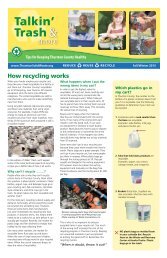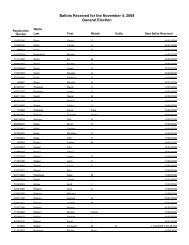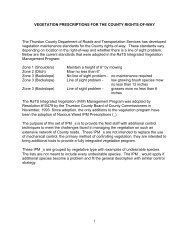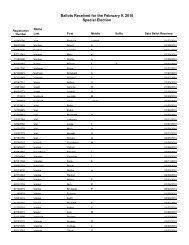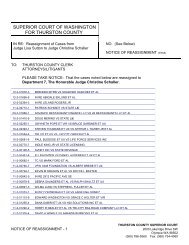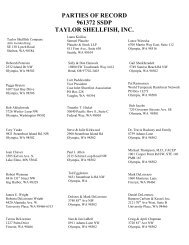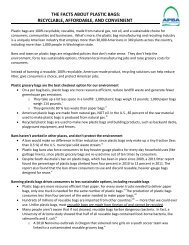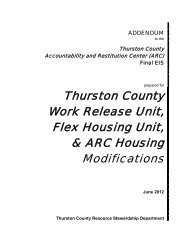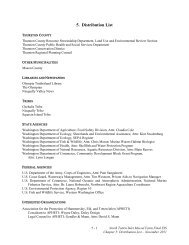Taylor's Checkerspot Butterfly - Thurston County
Taylor's Checkerspot Butterfly - Thurston County
Taylor's Checkerspot Butterfly - Thurston County
You also want an ePaper? Increase the reach of your titles
YUMPU automatically turns print PDFs into web optimized ePapers that Google loves.
esearchers found that females selected habitat with high host plant density for oviposition. Grosboll<br />
(2011) determined that the butterfly selected for host plant patches with >10,000 cm 3 volume. Severns<br />
and Grosboll (2011) found that the butterfly laid eggs more frequently along 2-track road edges than the<br />
open prairie, and explained this may be due to the strong association between the host plant at this site<br />
(English Plantain) and the road beds.<br />
Although there has been no quantitative study of Taylor’s <strong>Checkerspot</strong> nectar plant use or preference,<br />
several plants have been identified as key nectar sources in south Sound populations (Common Camas,<br />
Deltoid Balsamroot, Sea Blush, Wholeleaf Saxifrage, Nine-leaved Lomatium, and Spring Gold) (Jackson<br />
1982, Hays et al. 2000, Linders 2012, M. Linders, WDFW, unpubl. data, A. Potter, WDFW, unpubl.<br />
data). Because annual variation in plant phenology and condition determines the availability of nectar<br />
resources and causes variation in availability (and therefore use) among years, variety of nectar sources is<br />
an important habitat component.<br />
Threats/Reasons for Decline<br />
Prairie-oak butterfly species in the Willamette Valley-Puget Trough-Georgia Basin (WPG) ecosystem<br />
have declined dramatically due to widespread habitat degradation and loss of prairie-oak ecosystems in<br />
the region (Schultz et al. 2011). Also see the Factors Affecting Continued Existence section in the<br />
Washington State Status Report for Taylor’s <strong>Checkerspot</strong> for more complete and detailed information on<br />
threats (Stinson 2005, pp. 99-105).<br />
Habitat loss and fragmentation. Habitat loss is the consistent, primary factor driving species extinctions<br />
and declines world-wide (Groom et al. 2006), and the most common threat to butterfly populations (New<br />
et al. 1995). Prairies and oak woodlands in south Puget Sound have been converted to development,<br />
agriculture, gravel mines, and lost to forest succession resulting from the elimination of fire and other<br />
beneficial sources of disturbance. In 1997, Crawford and Hall conservatively estimated that over 60,000<br />
ha (>148,263 ac) of prairie existed historically in the south Sound region, and that only 3% of that<br />
remained dominated by native vegetation. Prairie loss has likely continued since 1997, but no updated<br />
estimates are available for this specific region. Chappell et al. (2001) refined the estimate of grassland<br />
habitat for the entire WPG ecosystem, and estimated the total amount of prairie, oak woodland, and<br />
grassland bluffs and balds prior to Euro-American settlement was over 72,000 ha (180,000 ac).<br />
Butterflies and other prairie species are also affected by fragmentation of their habitat. Crawford and Hall<br />
(1997) found that historically in south Puget Sound there were 233 prairie sites, averaging 250 ha (618 ac)<br />
in size, including 18 large prairies (>405 ha), and contrasted that to 1997 conditions: 29 prairie sites,<br />
averaging 175 ha (432 ac) in size, with only 2 large prairies extant. Fragmentation of prairies directly<br />
threatens prairie butterflies by creating smaller and isolated populations, which increases the potential for<br />
population loss and inbreeding. <strong>Butterfly</strong> habitat fragmentation also occurs within prairies from habitat<br />
degradation that results in small, disjunct patches of suitable habitat.<br />
Invasive species. Invasive plants have dramatically altered the ecological function of Pacific Northwest<br />
prairies (Dunwiddie and Bakker 2011). Woody shrubs, including Scot’s Broom, and non-native grasses,<br />
especially Tall Oatgrass (Arrhenatherum elatius), Bentgrasses (Agrostis), and Sweet Vernal Grass<br />
(Anthoxanthum odoratum) have invaded most extant south Puget Sound prairies. Uncontrolled, these<br />
plants dominate native prairie vegetation, including Taylor’s <strong>Checkerspot</strong> larval and nectar plants, and<br />
change vegetation structure and soil conditions. Tall grasses (Slender False Brome (Brachypodium<br />
sylvaticum) and Tall Fescue (Festuca arundinacea)) deterred Taylor’s <strong>Checkerspot</strong> egg-laying and<br />
reduced cover of larval and nectar plants in the Willamette Valley, Oregon (Severns and Warren 2008).<br />
6



